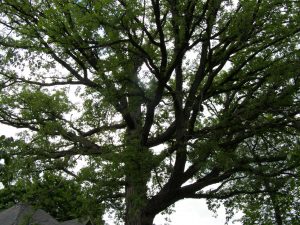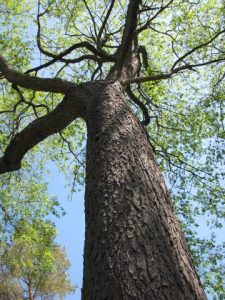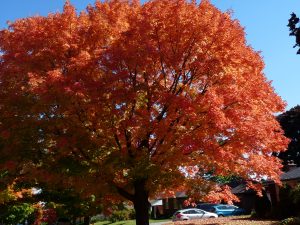Council expected to revisit Peterborough’s suspended tree bylaw later this fall
I have always loved trees. As a kid I delighted in climbing the sugar maples near our house and seeing how high I could go until terror set in. I also spent countless hours playing “chestnuts” with the shiny brown nuts from an old horse-chestnut tree on the Upper property on Merino Boulevard. Bruce Upper used to say, “The chestnut monkeys are back in the tree again!” We would drill a hole through the nut, attach it to a string, and take turns striking our opponent’s chestnut until it shattered.
Now, as an adult, planting trees has become a passion – no less than 30 on our property in the past 25 years. I relish everything they have to offer: the fall foliage, the winter twigs and buds, the spring leaf emergence, the summer shade, the intriguing flowers and seeds, the diversity of species, the calm they bestow on the human psyche, the beauty and grace they give to city streets and, of course, their incredible value to wildlife. Even a dead tree is an “infinite hotel” for other species. As a contributor to the 2013 book “Beneath the Canopy: Peterborough’s Urban Forest and Heritage Trees”, my eyes were opened to the many iconic local trees. Some of my favourites are the two towering bur oaks on Homewood Avenue and Sherbrooke Street (at Albertus), the Douro Street gingko, the Camperdown elm at Little Lake Cemetery, and the enormous red oak on Aberdeen Street.
As Peter Wohlleben writes in “The Hidden Life of Trees” we should also care about trees because of the wonders they present. We’re learning how trees communicate with one another, both over the air through scent and underground through a “wood wide web” of soil fungi. We now know that trees care and feed each other, orchestrating shared behaviours through the networks in the soil. They can even count, since trees must wait until a certain number of warm days has passed before leafing out in the spring.
As we head towards an election in which climate change is front and centre in voters’ minds, let’s also remember how important trees are in storing carbon from atmospheric carbon dioxide. The carbon in a tree’s wood, leaves, and roots makes up nearly 50 percent of its biomass. In this way, trees are a vital part of Peterborough’s Climate Change Action Plan, which includes a greenhouse gas emissions reduction target of 30 percent by 2031.
As Dr. Rosana Salvaterra wrote in her article in Tuesday’s Examiner, there is abundant evidence showing the negative impact that climate change has on health, including the risk of triggering mental-health issues. There is proof that simply living near trees improves our health – both physical and mental. A 2015 study carried out in Toronto by Marc Berman found that people who live in neighborhoods with a higher density of trees on their streets report significantly higher health perception and significantly less cardio-metabolic conditions. The researchers suggest that the benefits trees confer may relate to an improvement in air quality, relieving stress, and promoting walking. This is not surprising; we all feel better in the presence of trees.
Trees also increase property values by making individual properties and entire streets and neighbourhoods more beautiful. One of the reasons the Avenues neighbourhood in Peterborough (south of Charlotte Street between Park and Monaghan) is such a desirable place to live is the large number of mature trees. Trees also keep our lawns healthy, decrease the need for watering, and act as giant air filters. Their leaves and needles catch soot, toxic hydrocarbons, pollen, and dust as these particles float by.
Under siege
Trees, however, are under siege from every quarter, be it fungal disease, invasive species, drought, freezing rain, windstorms, or land development. The loss of city ash trees to the emerald ash borer has been especially devastating. If you look at photographs of locations in the city that once harboured healthy ash and then compare these to photographs taken after they were cut down, the difference is shocking. It’s not until trees are gone that we realize what’s been lost. Sadly, there are also many people who seem to love nothing more than to cut trees down, often because they deem them “dirty” or don’t like raking leaves.
Unfortunately, tree removal became all the easier last March when city council decided to suspend Peterborough’s tree conservation bylaw, bowing to pressure from developers and tree maintenance companies. The process was flawed, however, since only opponents to the bylaw voiced their position to council. There was not sufficient time or notice provided for people to speak out in support of the bylaw. In council’s rush to make a decision, even the city’s standing committee on trees, “Made for Shade”, was left out of the consultation process. They were completely blindsided. This committee was originally set up to protect children’s health by assuring that trees be planted in playgrounds, parks, and schoolyards to provide shade. Council’s decision was also made with little consideration for the bigger picture, such as doing everything possible to support the Peterborough Climate Change Action Plan.
To be fair, the old bylaw, passed in 2017, was not perfect. The approval process to get permission to remove a tree on private property was backed up, and property owners also had to replace felled trees with up to four new ones, which may have been excessive. Now that the bylaw has been suspended, however, permission to cut down a tree is no longer necessary. The only requirement is to provide 72-hour notice.
A new bylaw?
Council will soon consider making permanent changes to the bylaw – or scrapping it altogether. The city has hired Lura Consulting to engage in consultation with stakeholders. How widespread this consultation will be is not yet clear. While most trees in the city are on private property, the benefits they provide accrue to everyone. They affect our lives in positive and enduring ways.
I believe it’s important that some kind of permission-granting process remain in the by-law, especially for large trees. A fine, too, may still be necessary if this requirement is ignored. The bylaw should also stipulate that every felled tree be replaced – either on the same property or at another location approved by the city – and that the property owner commit to assuring the new tree survives. This may require some kind of monitoring. There should also be requirements as to the size and species of the replacement trees. It’s also worth investigating whether property owners with large trees could receive some kind of municipal tax credit. This would be a further incentive to protecting trees. A revamped bylaw must also afford protection to distinctive, iconic trees in the city and include an education program on the importance of urban trees.
Finally, it’s vitally important that the city continue planting and maintaining new trees to reverse the loss of the urban canopy. The city’s efforts in this regard should be applauded. The number of new trees being planted is truly impressive, as is the species diversity and the care (e.g, water bags) provided. It’s wonderful to see southern species like hackberry and American sycamore appearing on city streets. As global heating worsens, southern species should be able to withstand the heat stress more than native, central Ontario species.
Let’s hope that the city is able to craft a workable but robust bylaw that will protect our urban forest. Trees improve our quality of life and provide a visceral connection to the natural world – one that is available to all citizens and just outside the back door.
Climate Crisis News
The most disappointing climate news this week was Monday’s decision by city council to defer declaring a climate emergency this fall and, instead, ask for a staff report on the matter. The report is not expected until early 2020. Given the urgency of addressing the quickly worsening climate crisis, this decision is most troubling. When we cast our votes next month, climate change should be front and centre in our minds. Declaring a climate emergency in Peterborough ahead of the election is therefore incredibly important. It would be a powerful tool in focusing voters’ attention.
There might be a compromise solution, however. A climate emergency could still be brought forward and ratified by council on September 23, while specific actions tied to the declaration would be announced when reports are received from city staff and from the new Environmental Advisory Committee in early 2020.
On Wednesday evening, Kingston city councillor Robert Kylie spoke at a standing-room-only meeting on climate change, organized by Peterborough Youth Empowerment. He explained how Kingston went about declaring a climate emergency last March. One of the “whys” for the declaration is the huge impact that the coming extreme heat events will have on Kingston’s large population of seniors. As in Peterborough, they are among Kingston’s most vulnerable people. To their credit, Peterborough councillors Clarke, Parnell, Vassiliadis, Baldwin, Riel, and Akapo attended the event. Let’s hope that they, too, feel the urgency of supporting an immediate climate emergency declaration the same way that Kingston councillors did. In Kingston, support for the declaration was unanimous.


